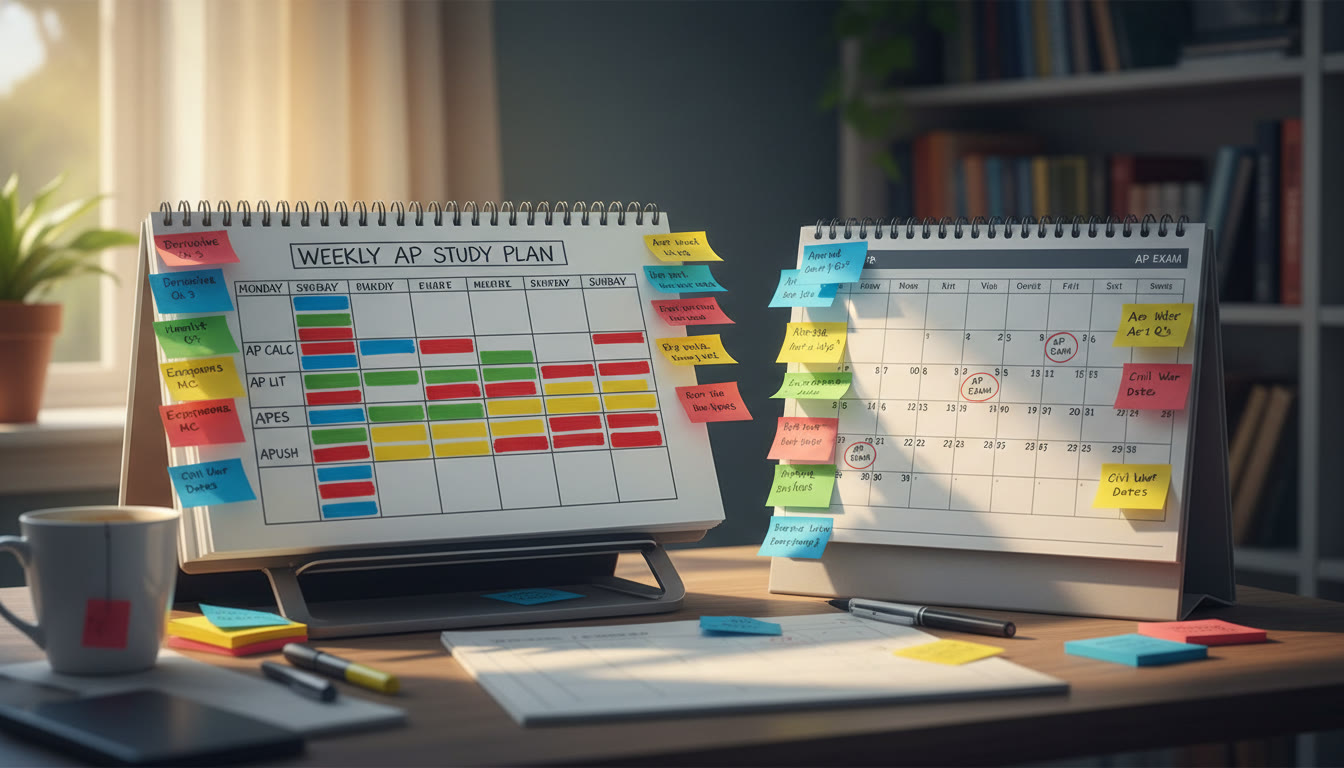Cross-Course Pacing Beacons: Know If You’re On Track
There’s something quietly thrilling about the week when everything clicks: you finish a practice set on time, your notes feel organized, and the topics you once dreaded now feel like old friends. For students juggling multiple AP courses, those moments don’t happen by accident—they’re the result of good pacing. Today we’ll map out what “on track” looks like across courses, how to recognize warning signs, and practical systems you can use to course-correct without panicking. This post is written for you—the student balancing chemistry problem sets with AP Literature essays, balancing thematic analysis and lab reports, hours stretching thin but ambition still high.
Why cross-course pacing matters
Pacing isn’t just a calendar trick. It’s the habit that turns sleepless cramming into steady growth. When you pace well across multiple AP classes, you get three big wins:
- Predictability: you reduce last-minute surprises and know when to allocate energy.
- Retention: spaced practice beats massed practice—steady exposure helps long-term memory.
- Well-being: consistent pacing preserves sleep, reduces stress, and helps you sustain focus.
Think of pacing as the scaffolding around your learning. The scaffolding supports the building, but you’re still the architect—your decisions about where to place study time, when to review, and how to practice matter.
How to define “on track” for each AP course
“On track” is not one-size-fits-all. It’s a relative scorecard made from three components: curriculum coverage, skill targets, and assessment readiness. Below is a simple rubric you can adapt.
Three-part rubric to gauge being on track
- Curriculum coverage: Are you hitting the units and big ideas the College Board emphasizes? Coverage should be within one to two lessons of your syllabus timeline for a classic “on track” rating.
- Skill targets: Each AP has core skills—analysis for AP English, problem solving for AP Calculus, experimental design for AP Biology. Identify the top 3 skills for the month and check whether you’re improving on them through guided practice and feedback.
- Assessment readiness: Are your scores trending up on practice questions and timed sections? It’s not about perfection; it’s about direction. Small, consistent improvements mean you’re pacing well.
Build a cross-course pacing plan in 6 steps
Use this as your template. It’s flexible enough for honors students taking three APs and for ambitious seniors taking five.
1. Start with backward planning
Ask: when are the exams, big projects, and final unit assessments? Count backwards from those dates, and block in high-intensity study windows. For AP exams, build two tiers of prep: end-of-semester review and the final six-to-eight-week concentrated review. Within each tier, assign topics to the weeks leading up—this is your master map.
2. Divide weeks into focus blocks
Break your weekly study time into predictable blocks: two content-building blocks (to learn and reinforce new ideas), one skills block (practice timed essays or problem sets), and one review block (spaced retrieval and corrections). This creates a routine you can repeat across courses.
3. Use a simple visual tracker
Visual trackers—nothing fancier than a two-page spread or a digital calendar—help you spot falls in momentum. Below is a sample weekly tracker you can adapt. Keep it visible: sticky notes on a study wall or a pinned calendar helps maintain accountability.
| Day | Course A (Content) | Course B (Skills) | Course C (Review) |
|---|---|---|---|
| Monday | New Topic + Notes | Timed Practice (30 min) | Flashcard Review (15 min) |
| Wednesday | Problem Set | Essay Draft | Retrieval Practice |
| Friday | Lab / Project Work | MCQ Drill | Summary Notes |
4. Align practice with the exam format
Match practice to the actual exam—timed sections, question types, and scoring. For example, if your AP course emphasizes free-response explanation, time-block multiple weekly sessions for that exact format. If an exam values quantitative reasoning, schedule periodic longer problem sets that combine topics.
5. Build in micro-reviews every day
Five to 20 minutes of low-stakes review daily keeps ideas out of the “forgotten” pile. Use active retrieval (write quick summaries, solve one representative problem) rather than passive rereading. It’s astonishing how much sticking power short, regular reviews have.
6. Reassess every two weeks
Set a short, structured checkpoint every 10–14 days. Look at practice scores, comfort levels, and time spent. If your scores aren’t improving but time invested is high, it’s a signal to change strategies rather than double down on ineffective practice.
How to read pacing signals: green, amber, red
Turn everyday observations into actionable signals. Here’s a simple color system you can use for each course. At your bi-weekly reassessment, mark green, amber, or red for course health.
- Green — Coverage is within plan, practice scores trending up, and confidence growing. Keep the current plan but stay vigilant.
- Amber — Slight lag in coverage or mixed practice results. Do targeted correction: shorten scope, focus on highest-yield topics, or adopt a different practice modality.
- Red — Off-syllabus work backlog or flat/declining scores. Act fast: prioritize recovery blocks, ask for help, and lighten other obligations where possible.
Examples: Realistic pacing scenarios and fixes
Examples help you translate theory into action. Below are common situations and straightforward fixes.
Scenario A — The Crammer
Situation: You skipped weeks of small practice and now face a major unit test. You nail the high-level readings but struggle to apply methods under pressure.
Fix: Run two intense, focused sessions: one to patch conceptual gaps (2 hours) and one to simulate exam conditions (timed, scored). After the test, insert two maintenance sessions per week to avoid repeating the cycle.
Scenario B — The Scattershot
Situation: You study a little of everything but can’t confidently complete any full-length section.
Fix: Narrow your weekly aim. Choose two priority skills for the week and practice them exclusively in focused blocks. Replace unfocused review with targeted problem sets and immediate feedback.
Scenario C — The Over-Performer
Situation: You’re covering content faster than your teacher, but timed performance is stagnant.
Fix: Slow down intentionally. Swap a content block for skills training. Use the extra time to work on application—timed questions, synthesis prompts, mixed-topic sets.
Tools and templates that actually help
Not every tracker is created equal. Here are a few lightweight tools and templates you can implement in under 30 minutes.
- Weekly Study Matrix: The table above recreated in a bullet journal or spreadsheet. Fill cells with goals not tasks (e.g., “Master Newton’s Second Law problem set”).
- Two-Week Check Template: Course name, target skills, practice scores (last two attempts), time spent, color status, corrective actions.
- Micro-Review Queue: A running three-item list of concepts to revisit every day for 10 minutes.
How to use practice tests strategically
Practice tests are your lighthouse—but they can also be misleading when misused. Here’s how to get reliable information from them.
- Schedule practice tests at realistic intervals: once every 4–6 weeks for full-length exams, with shorter timed sections weekly.
- Treat early tests as diagnostic. Use them to identify weak areas, not to judge whether you’re instantly ready.
- After every test, spend as much time analyzing errors as you did taking it. The error analysis is where growth happens.
- Maintain a running error-log (topic, mistake type, corrective action). This converts tests into an efficient learning machine.
Balancing multiple APs: triage and priorities
When everything matters, prioritize ruthlessly. Answer two questions weekly: What will move my score most this week? What will prevent future backlogs? Use those answers to triage time.
| Priority | Action | Why it helps |
|---|---|---|
| Immediate (This Week) | Fix core misconceptions, complete missed assignments | Removes roadblocks that create cascading delays |
| Short-Term (2–4 Weeks) | Timed practice and targeted review | Builds exam stamina and application skills |
| Long-Term (6–8 Weeks) | Full-length practice tests and synthesis projects | Simulates test conditions and integrates learning |
When to ask for help—and how to ask
Asking for help is not an admission of failure; it’s a high-leverage move. Ask early if you notice any of these patterns:
- Practice scores plateau despite increased study time.
- You can explain concepts aloud but can’t apply them under time pressure.
- Assignments pile up and completion rates fall below 80%.
How to ask: Be specific. Bring a brief summary of what you’ve tried, a couple of practice items you struggled with, and a clear question: “Can you help me improve my approach to timed synthesis questions?” This focus makes tutoring efficient—whether you’re working with a teacher, a peer, or a service providing personalized help.
Smart ways to use personalized tutoring
When you add tutoring to your pacing plan, make it high-impact:
- Use 1-on-1 sessions for targeted skill gaps rather than general review.
- Ask tutors to help design a recovery week when you’re in amber or red territory.
- Request tailored study plans that align with your course syllabus and exam dates. Platforms that combine expert tutors with AI-driven insights can accelerate the process by highlighting your highest-yield weaknesses and tracking progress week to week.
For example, Sparkl’s personalized tutoring can fit naturally into this system by offering expert tutors who build tailored study plans, provide 1-on-1 guidance on weak skills, and use AI-driven insights to pinpoint which practice will boost your score most efficiently. When used selectively—after a diagnostic or when you hit an amber/red signal—personalized tutoring becomes an amplifier rather than a crutch.
Common pacing myths (and the reality)
- Myth: Studying longer always beats studying smarter. Reality: Focused, spaced practice beats long unfocused sessions nearly every time.
- Myth: Covering more topics means better readiness. Reality: Depth and application matter more than breadth close to exam time.
- Myth: If you’re good at practice tests, you don’t need a pacing plan. Reality: Even strong performers need structured revision to avoid late-season slumps.
One-month recovery plan template (when you fall behind)
If you wake up and realize you’re behind, follow this focused four-week plan to get back on pace without burning out.
| Week | Focus | Daily Actions |
|---|---|---|
| Week 1 | Stabilize | Patch core content gaps (60–90 min), 20 min retrieval daily |
| Week 2 | Practice | Timed sections every other day, error analysis after each |
| Week 3 | Consolidate | Mixed-topic practice sets, 2 full sessions of extended work |
| Week 4 | Simulate | Full-length practice test, targeted review of missed items |
Wrapping up: Keep the beacons bright
Pacing across multiple AP courses is part science (timelines, practice tests) and part art (self-knowledge, sustainable habits). Your aim is progress, not perfection. Use the simple tools here—weekly focus blocks, bi-weekly reassessments, and a triage system—to turn anxiety into momentum. When you need a stronger nudge, targeted 1-on-1 help can be a force multiplier; used wisely, it speeds recovery and refines technique.

A short checklist to see if you’re on track right now
- Have I scheduled end-of-term and exam-focused review windows? (Yes / No)
- Do I run at least one timed practice section per week per course? (Yes / No)
- Do I have a two-week reassessment ritual logged somewhere? (Yes / No)
- If a course is amber or red, do I have a corrective plan for the next two weeks? (Yes / No)
If you answered “No” to more than one, your beacons need attention. Start with one small change—add a daily 15-minute review or schedule a 1-on-1 tutoring diagnostic session to get a clear plan. Little consistent changes compound into big gains.

Final note
AP season is a marathon with many sprints. Use pacing to protect your energy, sharpen your skills, and keep your confidence. When you can read your own progress like a map—unit by unit, skill by skill—you’ll not only arrive at exam day calm and prepared but you’ll also remember more of what you learned afterward. That’s real success: stronger scores and stronger learning habits that last well beyond the test.
Ready to light your beacons? Pick one change from this post and commit to it for two weeks. Check back, measure, and iterate—your future self will thank you.



















No Comments
Leave a comment Cancel